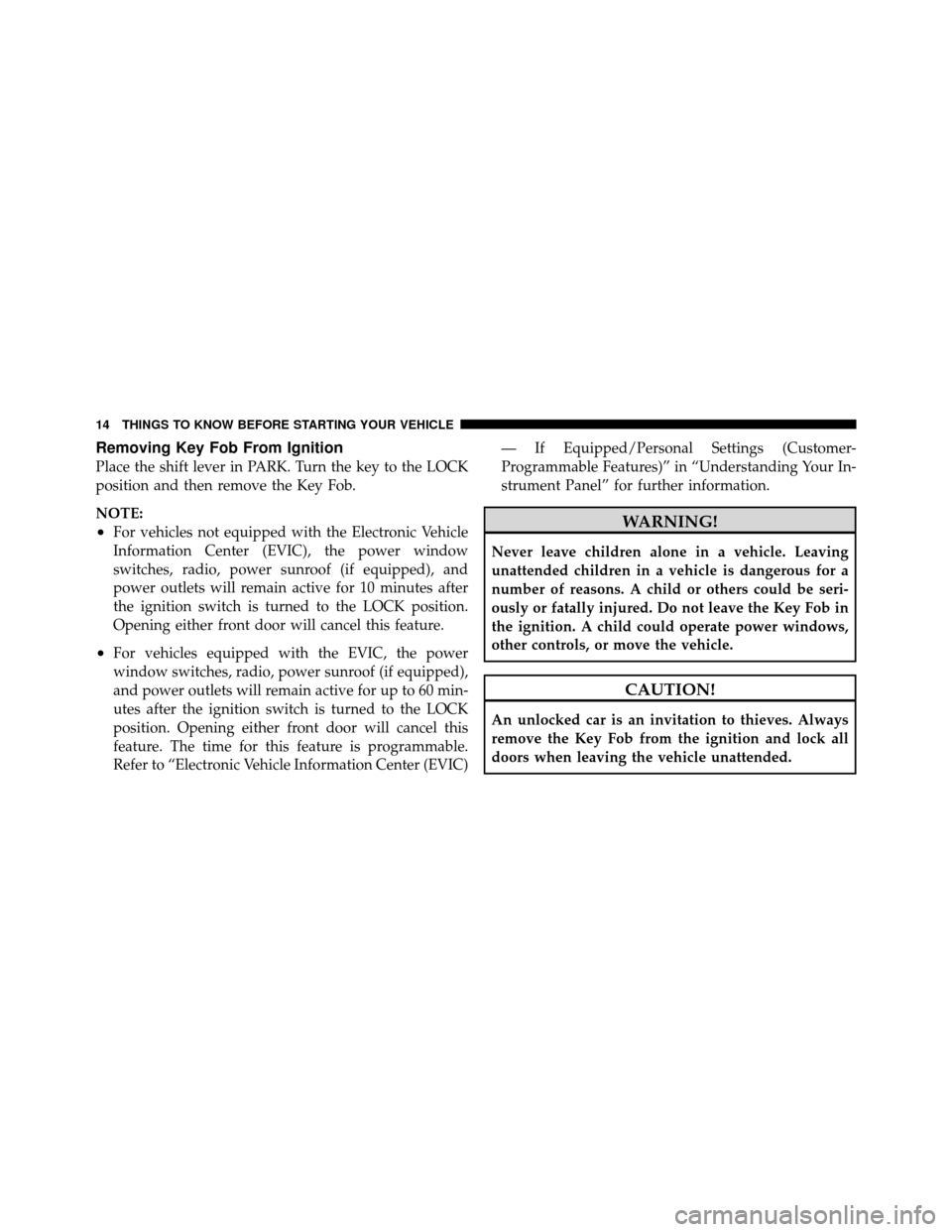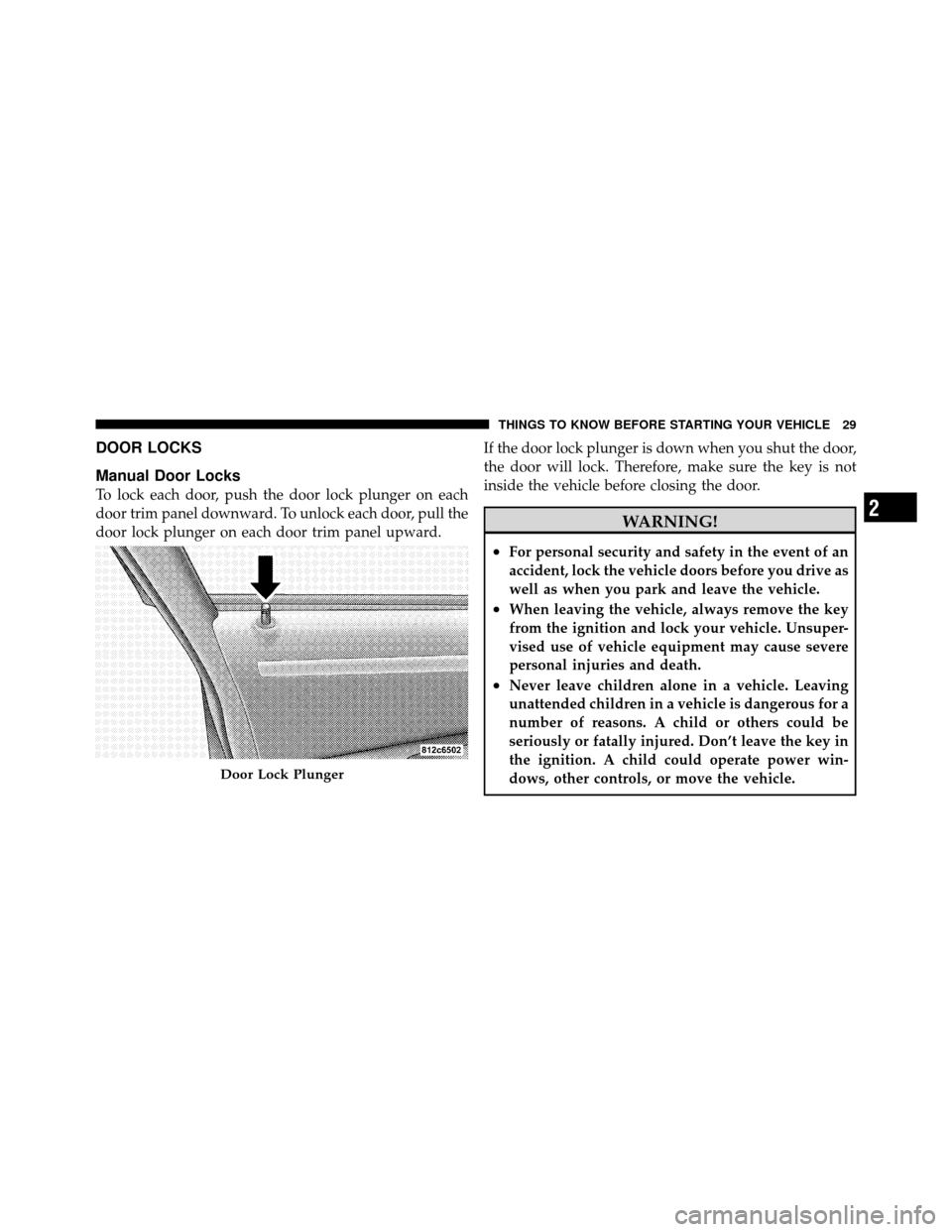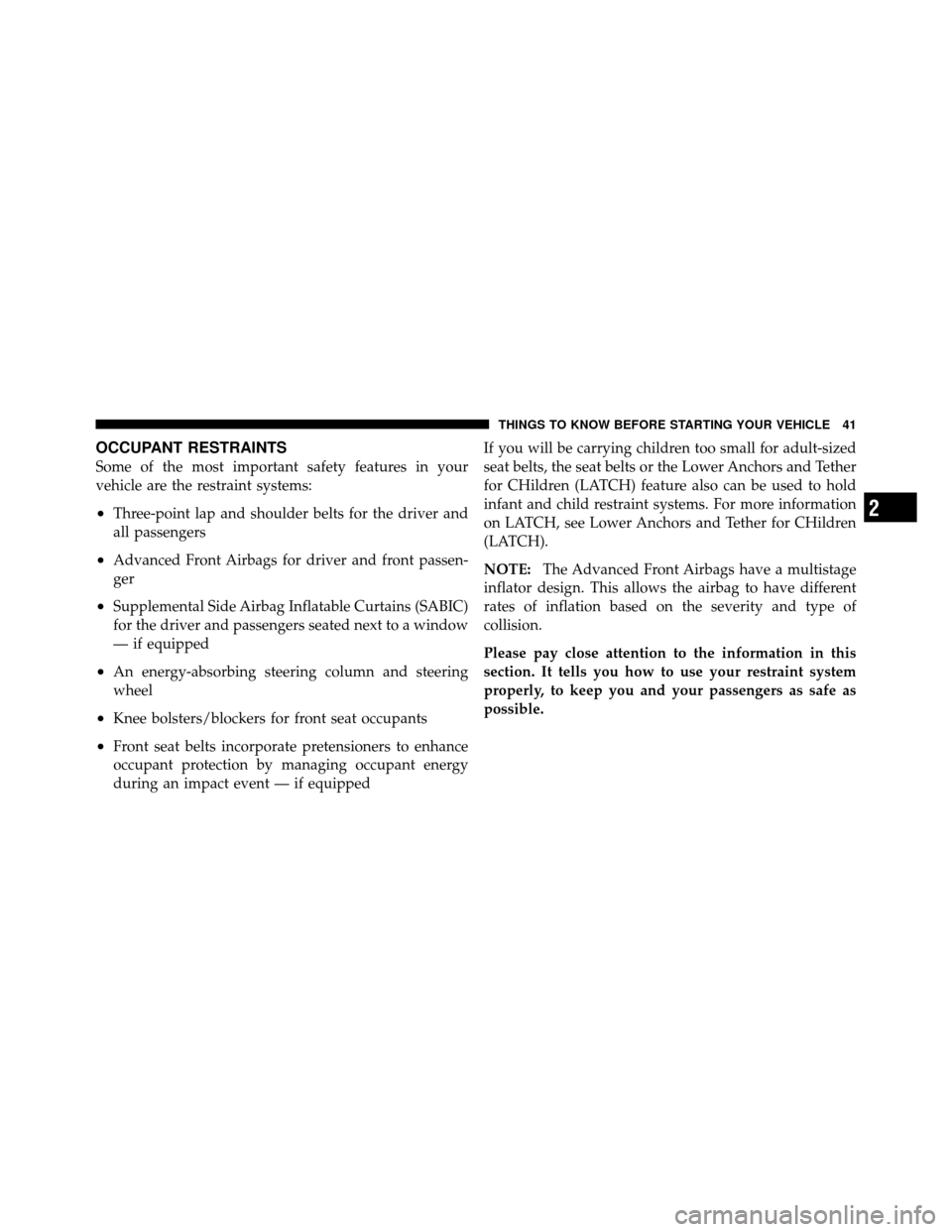Page 11 of 484

▫Using The Panic Alarm ................. 24
▫ Programming Additional Transmitters ...... 24
▫ Transmitter Battery Replacement .......... 24
▫ General Information ................... 26
� Remote Starting System — If Equipped ....... 26
▫ How To Use Remote Start ............... 27
� Door Locks ........................... 29
▫ Manual Door Locks ................... 29
▫ Power Door Locks .................... 30
▫ Child Protection Door Lock .............. 33
� Windows ............................ 35
▫ Power Windows ...................... 35
▫ Wind Buffeting ....................... 39 �
Trunk Lock And Release ................. 39
� Trunk Safety Warning ................... 40
▫ Trunk Emergency Release ............... 40
� Occupant Restraints ..................... 41
▫ Lap/Shoulder Belts .................... 42
▫ Lap/Shoulder Belt Untwisting Procedure .... 48
▫ Automatic Locking Retractors (ALR) Mode
— If Equipped ....................... 48
▫ Seat Belt Pretensioners — If Equipped ...... 49
▫ Enhanced Seat Belt Use Reminder System
(BeltAlert�) ......................... 49
▫ Seat Belts And Pregnant Women .......... 51
▫ Seat Belt Extender ..................... 51
10 THINGS TO KNOW BEFORE STARTING YOUR VEHICLE
Page 15 of 484

Removing Key Fob From Ignition
Place the shift lever in PARK. Turn the key to the LOCK
position and then remove the Key Fob.
NOTE:
•For vehicles not equipped with the Electronic Vehicle
Information Center (EVIC), the power window
switches, radio, power sunroof (if equipped), and
power outlets will remain active for 10 minutes after
the ignition switch is turned to the LOCK position.
Opening either front door will cancel this feature.
•For vehicles equipped with the EVIC, the power
window switches, radio, power sunroof (if equipped),
and power outlets will remain active for up to 60 min-
utes after the ignition switch is turned to the LOCK
position. Opening either front door will cancel this
feature. The time for this feature is programmable.
Refer to “Electronic Vehicle Information Center (EVIC)— If Equipped/Personal Settings (Customer-
Programmable Features)” in “Understanding Your In-
strument Panel” for further information.
WARNING!
Never leave children alone in a vehicle. Leaving
unattended children in a vehicle is dangerous for a
number of reasons. A child or others could be seri-
ously or fatally injured. Do not leave the Key Fob in
the ignition. A child could operate power windows,
other controls, or move the vehicle.
CAUTION!
An unlocked car is an invitation to thieves. Always
remove the Key Fob from the ignition and lock all
doors when leaving the vehicle unattended.
14 THINGS TO KNOW BEFORE STARTING YOUR VEHICLE
Page 28 of 484

How to Use Remote Start
All of the following conditions must be met before the
engine will remote start:
•Shift lever in PARK
•Doors closed
•Hood closed
•Trunk closed
•Hazard switch off
•Brake switch inactive (brake pedal not pressed)
•Ignition key removed from ignition switch
•Battery at an acceptable charge level
•RKE PANIC button not pressed
WARNING!
•Do not start or run an engine in a closed garage or
confined area. Exhaust gas contains Carbon Mon-
oxide (CO) which is odorless and colorless. Car-
bon Monoxide is poisonous and can cause serious
injury or death when inhaled.
•Keep Remote Keyless Entry (RKE) transmitters
away from children. Operation of the Remote Start
System, windows, door locks or other controls
could cause serious injury or death.
To Enter Remote Start Mode
Press and release the REMOTE START button
on the RKE transmitter twice, within five sec-
onds. The parking lights will flash and the horn
will chirp twice (if programmed). Then, the
engine will start and the vehicle will remain in the
Remote Start mode for a 15-minute cycle.
2
THINGS TO KNOW BEFORE STARTING YOUR VEHICLE 27
Page 30 of 484

DOOR LOCKS
Manual Door Locks
To lock each door, push the door lock plunger on each
door trim panel downward. To unlock each door, pull the
door lock plunger on each door trim panel upward.If the door lock plunger is down when you shut the door,
the door will lock. Therefore, make sure the key is not
inside the vehicle before closing the door.
WARNING!
•For personal security and safety in the event of an
accident, lock the vehicle doors before you drive as
well as when you park and leave the vehicle.
•When leaving the vehicle, always remove the key
from the ignition and lock your vehicle. Unsuper-
vised use of vehicle equipment may cause severe
personal injuries and death.
•Never leave children alone in a vehicle. Leaving
unattended children in a vehicle is dangerous for a
number of reasons. A child or others could be
seriously or fatally injured. Don’t leave the key in
the ignition. A child could operate power win-
dows, other controls, or move the vehicle.
Door Lock Plunger
2
THINGS TO KNOW BEFORE STARTING YOUR VEHICLE 29
Page 34 of 484
Child Protection Door Lock
To provide a safer environment for small children riding
in the rear seats, the rear doors are equipped with a Child
Protection Door Lock system.
To Engage the Child Protection Door Lock System
1. Open the rear door.
2. Insert the tip of the emergency key (or similar object)
into the child lock control and pull it upward.
NOTE:For emergency key information, refer to “A
Word About Your Keys”.
3. Repeat Steps 1 and 2 for the opposite rear door.
NOTE:When the Child Protection Door Lock system is
engaged, the door can be opened only by using the
outside door handle even though the inside door lock is
in the unlocked position.
Child Lock Control
2
THINGS TO KNOW BEFORE STARTING YOUR VEHICLE 33
Page 35 of 484
WARNING!
Avoid trapping anyone in a vehicle in a collision.
Remember that the rear doors can only be opened
from the outside when the child protection locks are
engaged. Failure to follow this warning may result in
serious injury or death.
NOTE:
•After engaging the Child Protection Door Lock sys-
tem, always test the door from the inside to make
certain it is in the desired position.
•For emergency exit with the system engaged, move
the door lock plunger to the UNLOCK position, roll
down the window and open the door with the outside
door handle.
To Disengage the Child Protection Door Lock
System
1. Open the rear door.
2. Insert the tip of the emergency key (or similar object)
into the child lock control and pull it downward.
Child Lock Control
34 THINGS TO KNOW BEFORE STARTING YOUR VEHICLE
Page 36 of 484
3. Repeat Steps 1 and 2 for the opposite rear door.
NOTE:After disengaging the Child Protection Door
Lock system, always test the door from the inside to
make certain it is in the desired position.
WINDOWS
Power Windows
The window controls on the driver’s door control all the
door windows.
There are single window controls on each passenger door
trim panel, which operate the passenger door windows.
The window controls will operate only when the ignition
switch is in the ACC or RUN position.
Power Window Switches
2
THINGS TO KNOW BEFORE STARTING YOUR VEHICLE 35
Page 42 of 484

OCCUPANT RESTRAINTS
Some of the most important safety features in your
vehicle are the restraint systems:
•Three-point lap and shoulder belts for the driver and
all passengers
•Advanced Front Airbags for driver and front passen-
ger
•Supplemental Side Airbag Inflatable Curtains (SABIC)
for the driver and passengers seated next to a window
— if equipped
•An energy-absorbing steering column and steering
wheel
•Knee bolsters/blockers for front seat occupants
•Front seat belts incorporate pretensioners to enhance
occupant protection by managing occupant energy
during an impact event — if equippedIf you will be carrying children too small for adult-sized
seat belts, the seat belts or the Lower Anchors and Tether
for CHildren (LATCH) feature also can be used to hold
infant and child restraint systems. For more information
on LATCH, see Lower Anchors and Tether for CHildren
(LATCH).
NOTE:
The Advanced Front Airbags have a multistage
inflator design. This allows the airbag to have different
rates of inflation based on the severity and type of
collision.
Please pay close attention to the information in this
section. It tells you how to use your restraint system
properly, to keep you and your passengers as safe as
possible.
2
THINGS TO KNOW BEFORE STARTING YOUR VEHICLE 41